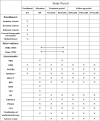Efficacy of functional magnetic resonance imaging-guided personalized repetitive transcranial magnetic stimulation (fMRI-rTMS) in depressive patients with emotional blunting: study protocol for a randomized controlled trial
- PMID: 38383418
- PMCID: PMC10880253
- DOI: 10.1186/s13063-024-07976-3
Efficacy of functional magnetic resonance imaging-guided personalized repetitive transcranial magnetic stimulation (fMRI-rTMS) in depressive patients with emotional blunting: study protocol for a randomized controlled trial
Abstract
Background: Emotional blunting is a symptom that has always been present in depressed patients. Repetitive transcranial magnetic stimulation (rTMS) is a safe and effective supplementary therapy for treating depression. However, the effectiveness and brain imaging processes of functional magnetic resonance imaging-guided personalized rTMS (fMRI-rTMS) in the treatment of depression with emotional blunting have not been observed in randomized controlled trials.
Methods: This study is a randomized, controlled, double-blind, and single-center clinical trial in which 80 eligible depressed patients with emotional blunting will be randomly assigned to two groups: a functional magnetic resonance imaging-guided personalized rTMS (fMRI-rTMS) group and a control group. Individuals in the fMRI-rTMS group (n = 40) will receive high-frequency rTMS (10 Hz, 120% MT). The main target of stimulation will be the area most relevant to the functional connectivity of the right medial prefrontal cortex (mPFC) and amygdala. The control group (n = 40) will receive sham stimulation, with a coil flipped to 90 degrees relative to the vertical scalp. All patients will receive 15 consecutive days of treatment, with each session lasting half an hour per day, followed by 8 weeks of follow-up. The primary outcome is the comparison of Oxford Depression Questionnaire (ODQ) scores between these two groups at different time points. The secondary outcomes include evaluating other clinical scales and assessing the differences in brain imaging changes between the two groups before and after treatment.
Discussion: This trial aims to examine the effects of functional magnetic resonance imaging-guided personalized rTMS (fMRI-rTMS) intervention on depressed patients experiencing emotional blunting and to elucidate the potential mechanism behind it. The results will provide new evidence for using fMRI-rTMS in treating depression with emotional blunting in the future.
Trial registration: ClinicalTrials.gov INCT05555940. Registered on 13 September 2022 at http://clinicaltrials.gov .
Keywords: Depression; Emotional blunting; FMRI-rTMS; Randomized controlled trial.
© 2024. The Author(s).
Conflict of interest statement
The authors declare that they have no competing interests.
Figures


Similar articles
-
Active versus sham DLPFC-NAc rTMS for depressed adolescents with anhedonia using resting-state functional magnetic resonance imaging (fMRI): a study protocol for a randomized placebo-controlled trial.Trials. 2024 Jan 13;25(1):44. doi: 10.1186/s13063-023-07814-y. Trials. 2024. PMID: 38218932 Free PMC article.
-
mPFC-rTMS for patients with insomnia disorder using resting-state functional magnetic resonance imaging: a protocol for a randomized controlled trial.Trials. 2022 Dec 12;23(1):1005. doi: 10.1186/s13063-022-06934-1. Trials. 2022. PMID: 36510305 Free PMC article.
-
Influence of prefrontal target region on the efficacy of repetitive transcranial magnetic stimulation in patients with medication-resistant depression: a [(18)F]-fluorodeoxyglucose PET and MRI study.Int J Neuropsychopharmacol. 2010 Feb;13(1):45-59. doi: 10.1017/S146114570900008X. Epub 2009 Mar 9. Int J Neuropsychopharmacol. 2010. PMID: 19267956 Clinical Trial.
-
Open-label, short-term, repetitive transcranial magnetic stimulation in patients with Alzheimer's disease with functional imaging correlates and literature review.Am J Alzheimers Dis Other Demen. 2014 May;29(3):248-55. doi: 10.1177/1533317513517047. Epub 2014 Jan 13. Am J Alzheimers Dis Other Demen. 2014. PMID: 24421409 Free PMC article. Review.
-
Repetitive Transcranial Magnetic Stimulation for Patients with Depression: A Review of Clinical Effectiveness, Cost-Effectiveness and Guidelines – An Update [Internet].Ottawa (ON): Canadian Agency for Drugs and Technologies in Health; 2019 Jun 28. Ottawa (ON): Canadian Agency for Drugs and Technologies in Health; 2019 Jun 28. PMID: 31433608 Free Books & Documents. Review.
References
Publication types
MeSH terms
Associated data
Grants and funding
LinkOut - more resources
Full Text Sources
Medical

